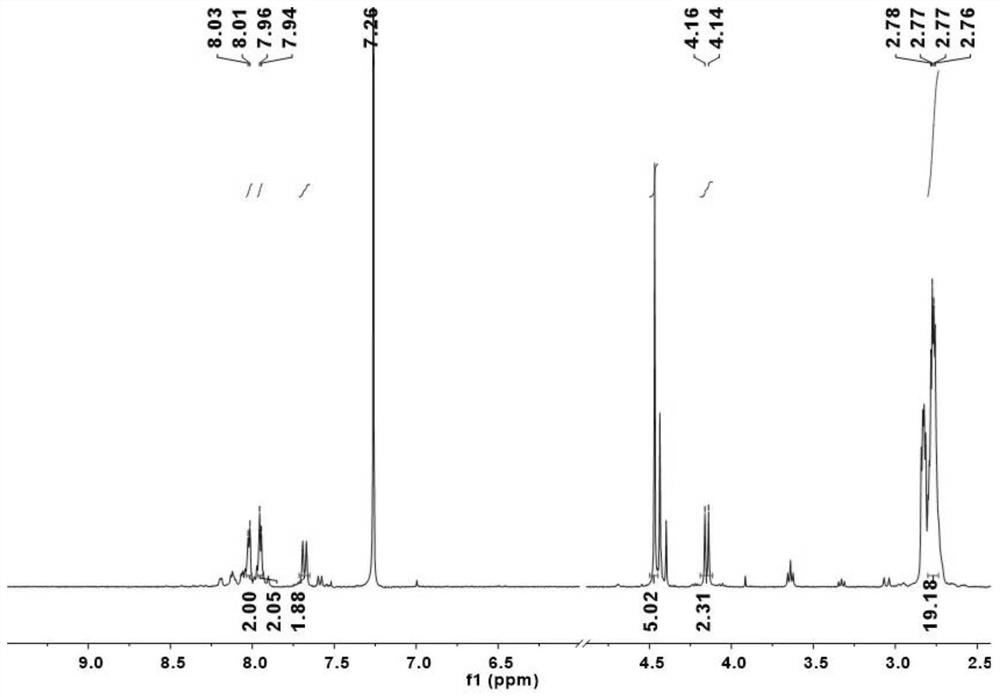PDT compound and preparation method and application thereof
A compound and complex technology, applied in the field of photosensitizing compounds and their preparation, can solve the problems of inability to realize diagnosis and treatment at the same time, complex composition of clinical photosensitizers, limited tissue penetration depth, etc. Injury, effect of large tissue penetration depth
- Summary
- Abstract
- Description
- Claims
- Application Information
AI Technical Summary
Problems solved by technology
Method used
Image
Examples
preparation example Construction
[0071] The present invention also provides the preparation method of above-mentioned PDT compound, comprising:
[0072] Step 1: Under anaerobic conditions, porphyrin and the acetylacetonate salt of the ionic ligand M are reacted at 200-240°C for 1-3 hours to obtain intermediate I; intermediate I and the sodium salt of the axial ligand L are dissolved in chloroform / React in the mixed solvent of methanol=1 / 1, obtain intermediate product I;
[0073] Step two:
[0074] Under an inert gas atmosphere, the intermediate product I was dissolved in the organic solvent I, and the reducing agent was added dropwise at -100 to -60°C, and the reaction was completed after returning to room temperature and protected from light to obtain the PDT compound.
[0075] Wherein, in step 1, it is preferred that the acetylacetonate salt of the ion ligand M is a sodium salt or a potassium salt, and its molar weight is 1 to 2 times that of the porphyrin molar weight; The reaction was completed in tric...
Embodiment 1
[0106] The synthesis of embodiment 1 compound Lu-1
[0107]
[0108] Step 1: Add Lu(acac)·6H to the Schlenk tube 2 O (lutetium acetylacetonate hexahydrate) 0.10mmol, porphyrin a (0.05mmol) and 8mL solvent trichlorobenzene, degassed, filled with nitrogen, sealed tube at 240°C for 1-3h. After monitoring the reaction system until there was no porphyrin fluorescence, it was cooled to room temperature. Separated by silica gel column chromatography, eluting with petroleum ether, dichloromethane, and dichloromethane / methanol=5 / 1 respectively, the rare earth porphyrins were collected. Rare earth porphyrin and Ligand tris (dimethyl phosphite) sodium cyclopentadienyl cobalt (Ⅲ) acid (NaL OMe ) (0.05mmol) dissolved in 10mL CHCl 3 / MeOH=1 / 1, react at 60°C for 2h, remove the solvent by rotary evaporation, separate the solid by silica gel column chromatography, and recrystallize from dichloromethane / n-hexane (1~10:10) to obtain Lu-a.
[0109] Step 2: Dissolve Lu-a in anhydrous an...
Embodiment 2
[0115] The synthesis of embodiment 2 compound Lu-2
[0116]
[0117] Reaction process is substantially similar to embodiment 1, difference is:
[0118] After getting Lu-1, further use BF 3 ·Et 2 O catalyzed etherification in methanol solvent to give Lu-2.
[0119] Structural Characterization Data:
[0120] UV / Vis(CH 2 Cl 2 ,25℃):λ max (nm)(logε): 345(4.99), 397(5.15), 509(3.98), 545(4.50), 690(4.16), 749(5.10).
PUM
 Login to View More
Login to View More Abstract
Description
Claims
Application Information
 Login to View More
Login to View More - R&D
- Intellectual Property
- Life Sciences
- Materials
- Tech Scout
- Unparalleled Data Quality
- Higher Quality Content
- 60% Fewer Hallucinations
Browse by: Latest US Patents, China's latest patents, Technical Efficacy Thesaurus, Application Domain, Technology Topic, Popular Technical Reports.
© 2025 PatSnap. All rights reserved.Legal|Privacy policy|Modern Slavery Act Transparency Statement|Sitemap|About US| Contact US: help@patsnap.com



